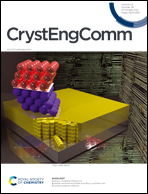Synthesis, crystal structures, dielectric and magnetic properties of manganese sulfonyldibenzoates†
Abstract
A systematic investigation of the system manganese(II) salt–H2SBA–auxiliary ligand–solvent successfully led to the isolation of six new multidimensional coordination polymers: [Mn5(2-pic)2(DMA)4(SBA)4]·4DMA (1), [Mn3(pyzc)2(DMF)(H2O)(SBA)2]·DMF·H2O (2), [Mn5(pyzc)2(DMA)4(SBA)4]·4DMA (3), [Mn5(mpyzc)2(DMA)4(SBA)4]·4DMA (4), [Mn2(phen)2(H2O)(SBA)2]·2DMA (5) and [Mn3(phen)2(SBA)3]·5DMF (6), where SBA = 4,4′-sulfonyldibenzoate 2-pic = 2-picolinate, pyzc = 2-pyrazinecarboxylate acid, mpyzc = 5-methyl-2-pyrazinecarboxylate and phen = 1,10-phenanthroline. The selected use of N-containing ligands to block the coordination sites of manganese enabled us to understand their influence in controlling the nuclearity and the dimensionality of the extended manganese carboxylate coordination networks. Single crystal X-ray crystallography established that the structures of all the solids were built of homometallic clusters varying from monomeric to pentameric manganese(II) carboxylate units. While the solids 1, 3 and 4 are isostructural, possessing a 2D coordination network containing pentanuclear SBUs of the composition {Mn5N2O3}, the 2D solids 2 and 5 are respectively built from binuclear {Mn2N4O7} and trinuclear {Mn3N2O14} SBUs. The solid 6 is the lone example of a 3D coordination network in this system. Dielectric measurements showed comparable dielectric behavior for the isostructural solids 1, 3 and 4 with ε′ ∼ 17 at room temperature. Relatively lower values observed for 2 and 5 (ε′ ∼ 14) were due to a combined effect of strong manganese carboxylate interaction and the presence of ordered polar guest molecules. Significantly higher values for 6 (∼21) could be attributed to disordered guest molecules. All the six solids exhibited antiferromagnetic behavior at lower temperatures. This paper also discusses the growth of the solids in terms of supramolecular aggregation of manganese carboxylate complex species with or without an auxiliary ligand, proposing a mechanistic pathway to trace the chemical events from molecules to the final solid.

- This article is part of the themed collection: Coordination Networks


 Please wait while we load your content...
Please wait while we load your content...